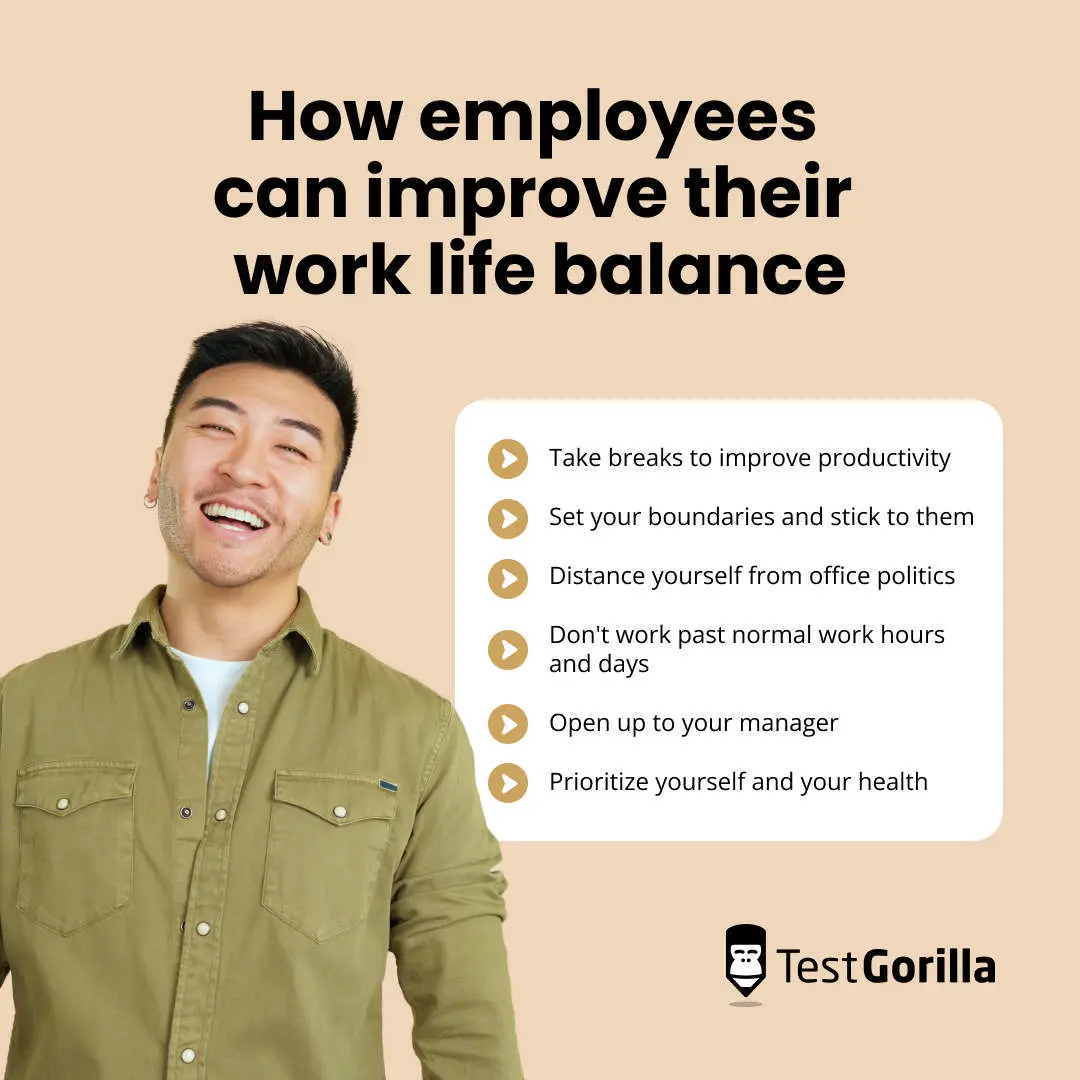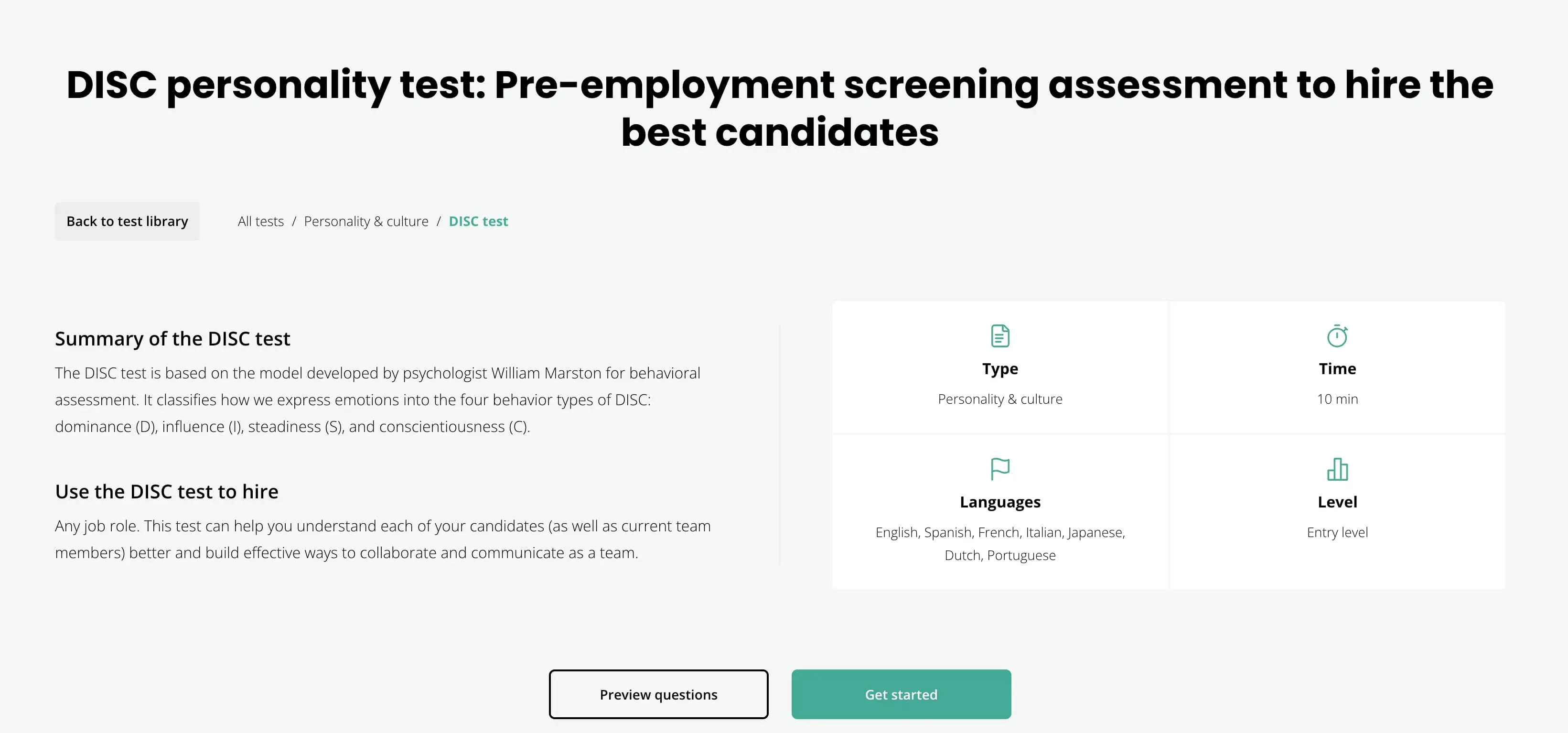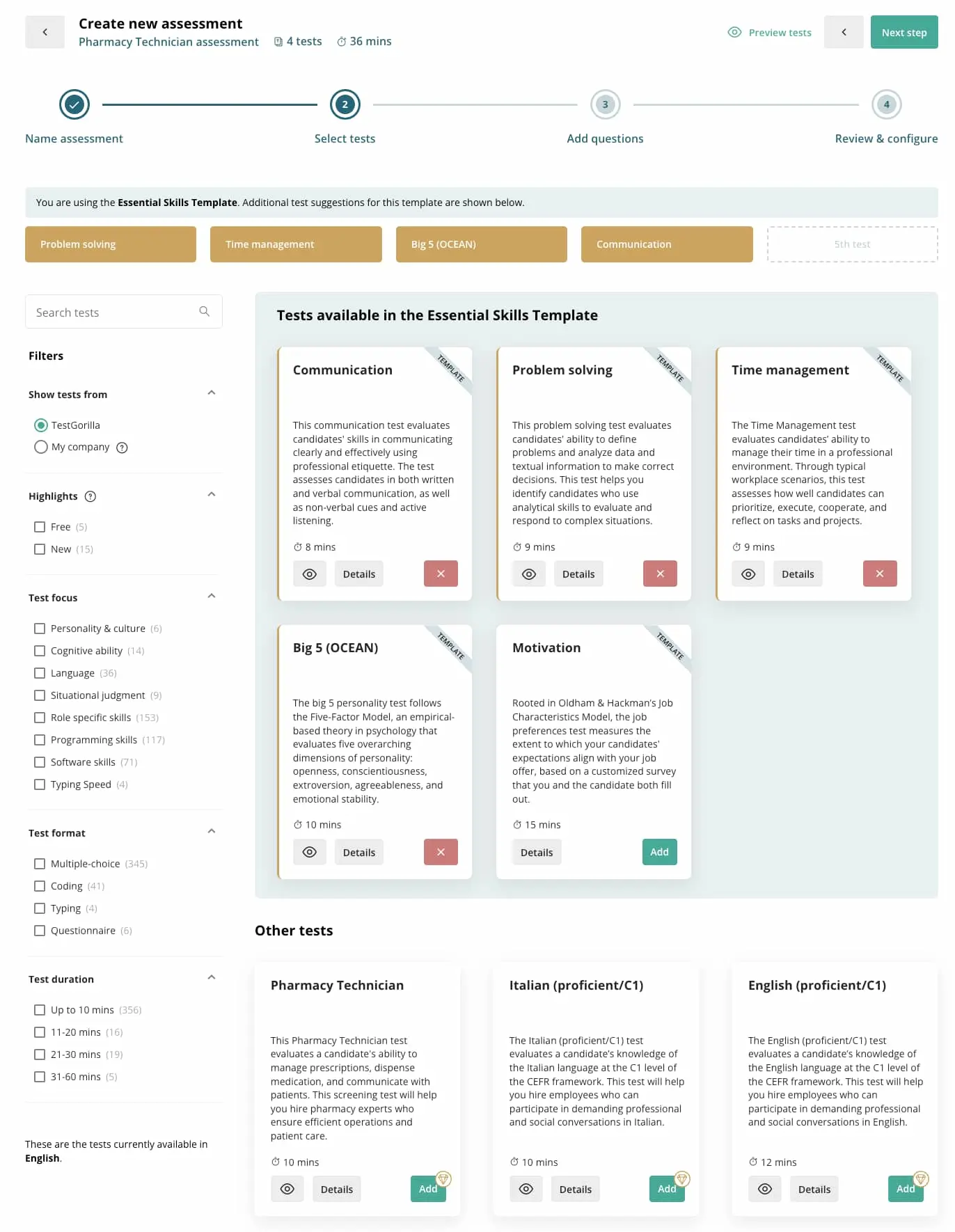Poor work life balance is making headlines with the advent of working from home and anywhere, but it’s far from a recent issue.
Many employees were already experiencing a poor work life balance in 2019. More than 25% had leftover work to finish after hours and on weekends, and 40% of people were still working on their devices after 10 p.m.[1]
An unhealthy work life balance affects both employees and employers. Workers become demotivated and may experience burnout, and employers experience productivity and retention losses.
To have a happy, productive workforce that stays with your company, you need to take advantage of the employee retention trend of prioritizing employee work life balance.
This blog shows employees and employers how to create an inclusive culture that thrives on work life balance and employee wellbeing.
Table of contents
- What is work life balance?
- How employees can improve their work life balance
- The importance of work life balance for employers
- The benefits of work life balance for employers
- 9 best practices for leveraging employee work life balance as a retention tool
- Improving employee work life balance: 4 examples of companies succeeding with this talent retention trend
- Use work life balance to improve wellbeing and retain workers
What is work life balance?
Work life balance refers to how much time an individual spends working for a living versus how much time they spend focusing on their interests, responsibilities, and loved ones.
If one side overcomes the other, the worker’s overall wellbeing and quality of life decrease. The impact of work life balance on employee job satisfaction is also an issue.
Many successful talent retention strategies incorporate employee work life balance in the employer’s toolkit.
What does an unhealthy work life balance look like?
When professional life takes over leisure time, employees may become overwhelmed at work and home.
For example, working late or checking your emails at all hours can quickly take over your spare time and leave you exhausted at the end of the day.
A poor life work balance can have serious physical and mental effects on the workforce, including work-related burnout, anxiety, and depression.
To combat these issues and keep a high employee retention rate, employers need to ensure their employees’ work life balance doesn’t get out of whack.
How employees can improve their work life balance
The onus is not only on employers to ensure that their workforce’s work life balance aligns with their needs.
Employees can also improve employee work balance. Let’s see how before we discuss the implications for employers.
6 tips for employees on improving work life balance: A summary
Tip | What it does |
1. Take breaks to improve productivity | Helps you clear your mind and be more productive |
2. Set your boundaries and stick to them | Prevents burnout from never saying “no” and taking on too much |
3. Distance yourself from office politics | Enables you to focus on your work and avoid unpleasant interactions |
4. Don't work past normal work hours and days | Prevents issues related to stress and a lack of concentration, such as making mistakes |
5. Open up to your manager | Lets employees ask for help and access resources provided by managers |
6. Prioritize yourself and your health | Keeps you healthy and motivated and improves your overall wellbeing |
1. Take breaks to improve productivity
Research has shown that productivity is best when employees work for 52 minutes and then take a 17-minute break.[2]
Although most workplaces would frown upon such frequent interruptions, it’s a good guideline that shows the importance of taking breaks.
Breaks improve your productivity because they help your brain disengage and rejuvenate between tasks that require concentration.
To make the most of your breaks, try to take them at the same time every day, and avoid the temptation of checking work emails or even social media during your breaks.
If possible, go outside the office for a few minutes or take a brisk walk to clear your mind.
2. Set your boundaries and stick to them
Setting boundaries at work is important for a good work life balance.
You should avoid overwork, set your working hours, and, more importantly, stick to them.
Refuse to attend ad-hoc meetings that start close to the end of your day, and don’t hesitate to let your manager know that a meeting is inefficient and they should reschedule it.
Likewise, don’t be afraid to let colleagues and managers know that you are performing an important task by setting an away message on your email or closing your door.
Other boundaries that help your work life balance include:
Avoiding late-night work events
Always calling in when you’re sick or need a mental health day
Using your work calendar to schedule lunch breaks or other times when you’re unavailable
3. Distance yourself from office politics
One of the sure ways to have a poor work life balance is to engage in office politics.
Office politics include:
Gossiping about coworkers
Causing strife and workplace conflict
Keeping important information from others to sabotage their work.
When you or your team members engage in these behaviors, you waste time at work and end up with extra work to tackle after hours. Besides, a toxic work environment is not conducive to productive work.
Walk away from any colleague or group that doesn’t engage in fair and ethical behavior at work, and always act respectfully and inclusively with everyone.
Office politics can escalate to the point where they affect your wellbeing and mental health. Keeping them to a minimum is one way to improve your work life balance.
4. Don't work past normal work hours and days
We briefly touched on this tip in our section about boundaries above. However, it deserves its own section because working past your normal work hours and days is an easy way to ruin your work life balance.
To avoid that, delegate work, refuse to work weekends, and avoid micromanaging coworkers. If possible in your industry, keep overtime to a minimum.
Most employees can only maintain optimum concentration for 60 to 90 minutes, which means that after eight hours of work, they can’t focus well and maintain productivity.[3]
5. Open up to your manager
Many employees feel guilty about needing more time for themselves or taking breaks. Research has found that 39% of employees skip or don’t take breaks at work, and 22% feel guilty about taking lunch breaks.
Acting this way is not conducive to a better work life balance. If you feel burnt out, stressed, or pressured by tight deadlines, talk to your manager.
Ask them for support, whether in the form of an extension or redistribution of your tasks, so you have more time to complete them and more time for self-care.
6. Prioritize yourself and your health
Finally, ensure you take the “balance” in work life balance to heart.
You’re the only one who can prioritize your own needs and physical and mental health.
Always give yourself time to attend to your physical health, whether by going for a walk after work or on your lunch break, or by eating a balanced diet.
Don’t forget your mental health. You can use a mindfulness or meditation app, or attend courses and seminars on mental health issues you may be facing.
The importance of work life balance for employers
Work life balance is not only important for employees; it’s also fundamental to employers’ success.
Companies that offer employees a good work life balance become more attractive workplaces, improving their employer brand and tempting more top talent to join their ranks.
A good work life balance also improves employees’ mental and physical health by reducing their chances of burnout – which, in turn, reduces the organization’s health and sickness-related costs.
Having employees work longer hours and putting in more work doesn’t equal better productivity.
As seen above, the longer a worker spends on the job, the lower their productivity. Employees with balanced work and personal lives have more energy and work productively.
The benefits of work life balance for employers
Improving employee work life balance is important for your bottom line and employer branding, and you can draw other tangible benefits from this trend.
Let’s look at the main advantages of prioritizing work life balance for organizations.
Benefit | How it helps |
1. Increases retention and lowers employee turnover rates | - More than 25% of employees cite stress, and 23% cite burnout as the reasons they want to leave their jobs. - The same study found that 54% of women said being offered flexible time off would change their minds about leaving their jobs. - Therefore, a good work life balance would lower your employee attrition rate and help you keep key workers. |
2. Higher employee engagement and lower burnout | - Having too much or little to do at work and not feeling supported causes burnout. - Burnout is often associated with disengagement and an inability to find enough energy to focus on the job’s demands. - Offering adequate work life balance to employees improves their engagement levels and reduces their chances of burnout. |
3. Improved productivity | - A good work life balance gives employees better focus and concentration, more motivation, and lower stress levels, enabling them to perform at their best and be productive[4]. - By contrast, employees who experience high-stress levels are unproductive and likely to make mistakes, impacting work safety. - This impact of work life balance on employee performance shows its importance in improving productivity. |
4. Improved commitment | - Research shows that work life balance has a significant positive effect on organizational commitment. - Committed employees are invested in your business’s growth and want to see it succeed. |
9 best practices for leveraging employee work life balance as a retention tool
Having understood the importance of using work life balance to reduce your overall employee flight risk, it’s time to cover how we can use best practices to maintain balance.
Let’s start with a quick look at how to improve your employees’ work life balance and create an inclusive culture before diving into all the details.
Tips for increasing employee retention with better work life balance: A summary
Best practice | What it accomplishes |
1. Hire employees with the right skills for the job | Makes work life balance possible by picking the most qualified candidate for the job |
2. Lead from the top | Models a healthy work life balance for all workers |
3. Offer support for working parents | Gives working parents specific and targeted resources, like help with their home life, to assist with their situation |
4. Acknowledge that each employee is different | Ensures that all employees can benefit from work life balance rather than just specific groups |
5. Offer flexible work | Enables employees to choose the best way to work and maintain work life balance |
6. Encourage a healthy work life balance for remote workers | Keeps remote workers connected to the rest of the workforce and prevents burnout |
7. Focus on productivity and results more than hours | Uses metrics other than hours worked to measure productivity, letting employers understand the value of their employees’ work |
8. Insist that employees take breaks and time off | Ensures that all employees are well rested and able to function properly at work |
9. Consider mental and physical health | Improves employee wellbeing by offering resources to help them take care of their mental and physical needs |
1. Hire employees with the right skills for the job
One of the ways to improve work life balance is to ensure you’re only hiring the right people for each job.
Because they are more productive at work, these workers get more done during the day and enjoy their time off without work disruptions.
Talent assessments let you find the candidates with the right hard skills for the job, but they also gauge soft skills that help with work life balance.
For example, our personality and culture assessments, like the DISC test, can check for a candidate’s adaptability and resilience, which help them manage their work life balance.
You can personalize these assessments for each open position. For example, a pharmacy technician assessment has the following tests to assess their hard and soft skills.
Work life balance and employee productivity positively correlate and enhance your employees’ job satisfaction.
2. Lead from the top
When it comes to work life balance, managers need to lead by example. If they only pay lip service to having a healthy balance of work and free time, the employees notice and follow their example.
If your executives stay late every day, take their work home on the weekends, come into work sick, and postpone or don’t take their personal time off, your workers are likely to follow their example.
Encourage your managers to have a healthy work life balance. If they must occasionally work overtime or do some work on the weekend, tell them to fly under the radar and not use communication channels freely.
Otherwise, their direct reports may assume overtime and weekend work is the norm.
Also, train your managers to check on their employees.
They can use one on one meetings to find out whether their workers leave work on time most days, unplug on weekends, and feel anxious about work when they’re off the clock.
Likewise, you can organize work life balance initiatives, like implementing days when the entire team is encouraged to disconnect from their devices and enjoy a day off doing their favorite personal activities.
3. Offer support for working parents
Working parents have skills like empathy, time management, and the ability to remain calm under pressure, making them assets to your company.
Hiring parents also shows you have diversity in the workplace. Yet, working parents have specific work life challenges they need help with.
There are many ways to show your support to working parents:
Have hybrid options and flexible work with customized schedules
Ask parents what they need most help with in one-on-one meetings and pulse surveys, and use this feedback to change policies
Let employees work asynchronously whenever possible
Use employee resource groups to let peers support each other at work
Ask employees for their availability before scheduling meetings
Clarify which communications should be prioritized
Help parents with childcare costs, onsite daycare, parental leave, and family employee benefits
4. Acknowledge that each employee is different
Working parents are only one type of employee with specific work life balance needs. Other workers have particular needs to consider when you work on your work-balance policies.
For example, some of your workers may find nine-to-five jobs ideal, while others may want to break their week by taking Wednesdays off, working four-day weeks, or having different start times.
Some employees may need to work remotely because they are disabled or have too many responsibilities to handle the daily commute.
You can discover the specific needs of each employee with frequent employee surveys, like a work life balance questionnaire.
Work life balance is different for everyone, but you can devise solutions by using upward feedback to provide flexibility for everyone, bringing us to our next point.
5. Offer flexible work
Flexibility in the workplace is the biggest driver of balancing work and life.
Background check provider GoodHire surveyed 3,500 American workers and found that 45% of employees would take a pay cut if it meant they could continue working remotely. One-third of respondents would quit if their employers forced them to return to the office full-time.
However, being allowed to work remotely is not the only flexibility employees expect. Many of them want to also be able to choose their hours, especially in industries where asynchronous work is the norm, like e-commerce and digital companies.
Ask your employees about their needs and provide them with flexible arrangements.
Examples include:
Job sharing, where two part-time employees share a job
Telecommuting or working remotely
Shift work or allowing employees to work on different shifts
Condensed workweeks, where employees work the same number of hours but fewer days
Part-time work
Flextime or letting employees vary their start and finish times
6. Encourage a healthy work life balance for remote workers
It’s a common misconception that working remotely automatically gives employees the benefits of work life balance.
The opposite is often true. Research shows that more than two-thirds of employees who work from home have trouble setting boundaries and moving away from work at the end of their workday.
Without strict boundaries, workers often underestimate how much of their time gets eaten by “just getting a few things done” for their job.
To combat these problematic tendencies, use leadership communication to encourage remote employees to strictly work the hours they would at the office, take regular breaks, and avoid checking their email and work phone after hours.
Ensure your remote employees feel connected by including them in all work life balance initiatives you create for your in-office workers, including access to mental health resources and wellness apps.
7. Focus on productivity and results more than hours
Traditional management often equates productivity with working long hours. Many managers still expect workers to routinely work overtime and frown upon those leaving the office as soon as their workday ends.
This approach leads to poor work life balance.
Instead of focusing on how long tasks take, focus on the results. Look at productivity in terms of each employee’s ability to:
Complete tasks on time and to quality standards
Collaborate with team members (in-person and remote)
Focus on one task at a time and follow through until it is complete – the opposite of multitasking
Have and complete short- and long-term goals and priorities
Be able to deal with interruptions and maintain focus and concentration
Measuring results enables you to see where your employees are productive rather than how many hours they work.
In turn, this helps them improve their work life integration and gives you further opportunities to improve your processes to give them even more flexibility.
8. Insist that employees take breaks and time off
Offering perks like unlimited personal time off is easy, but it doesn’t make any difference to their work life balance if your employees don’t take advantage of it.
Working constantly, especially when employees are sick or under pressure, does not equate to being productive. Instead, it’s a sure way to experience anxiety and burnout.
Remind your employees of their time off. Insist that they don’t work through their lunch break regardless of how tight their deadline is – there’s always enough time to take care of their health. Encourage them to take small breaks throughout the day to stretch their legs and clear their mind.
Also, insist they take vacation time, discourage workers from coming in when they feel under the weather, accommodate doctor’s appointments, give workers paid sick leave, and assess how much paid time off they have.
Include all these recommendations in your wellbeing policies to promote a good company culture – and stick to them.
By providing an additional week or two of paid time off, companies can show their appreciation for their employees and signal that work life balance is valued in the organization.
A healthy workforce is a win-win for employers and employees, leading to our next point.
9. Consider mental and physical health
Consider your workers’ mental and physical health when developing employee training programs and policies to improve work life balance.
It’s easy to lose sight of either. For instance, you may offer fitness facilities or healthy snacks on your premises and think you’ve done your due diligence to improve your employees’ health.
To nurture both physical and mental health in the workplace, you should offer your workers:
Gym stipends or fitness facilities and classes
Access to counseling services (in person and remotely)
Stress management programs
Mental wellness apps
Wellbeing reimbursement programs
Meditation and mindfulness workshops and sessions
Use wellness surveys to get employee feedback about what mental and physical health resources your employees need to tailor your programs to their specific work life balance needs.
Improving employee work life balance: 4 examples of companies succeeding with this talent retention trend
Now that you know how to use work life balance initiatives effectively, let’s take a moment to explore three examples of organizations that are one step ahead.
Each has benefited greatly from improving its workers’ employee experience.
3 companies using work life balance to improve workers’ lives: A summary
Company | Its approach to work life balance |
Etsy | Uses flexible work and unlimited personal time off to help employees get the best out of their work life balance |
Agilent Technologies | Offers non-traditional wellness programs and nutritional guidance for workers |
General Motors | Covers fertility treatment costs and provides workers with extensive personal time off |
Etsy
Etsy, a popular consumer-to-consumer marketplaces, has a comprehensive and competitive work life balance benefit.
Its full-time employees have access to:
Unlimited sick and mental health days
26 weeks of fully paid parental leave
Paid four-week sabbatical every five years
In addition, Etsy offers its employees flexibility, letting them work fully remotely, fully onsite, or a combination, with a few days onsite each month.[5]
As a result, most of its employees report being satisfied with their work life balance.[6]
Agilent Technologies
Agilent Technologies, a global provider of scientific software and instrumentation systems and technologies, offers nontraditional employee wellness programs to improve its employees’ work life balance.
The company offers nutritional guidance and weight management for its employees. It also contributes to their healthy living by providing them with:
Nutritious food and drinks
Fitness centers
Commute subsidies
Bike lockers
Agilent Technologies also offers flexible work arrangements, has a remote work policy, and is ranked one of the 10 best companies for work life balance by US News.[5]
General Motors
General Motors, the famous automobile manufacturer, is a great example of a company that encourages a healthy work life balance in its employees.
The automaker offers extensive paid vacation in addition to 17 national holidays.
Parents enjoy 12 weeks of paid family leave and a $40,000 reimbursement for fertility treatments and adoption and surrogacy costs.[5]
GM employees generally rate the company’s work life balance positively.[7]
Use work life balance to improve wellbeing and retain workers
Work life balance helps employees stay motivated and engaged at work by improving their wellbeing and making them more satisfied with their jobs.
When you offer flexible work schedules, support all your employees’ needs, and focus on productivity rather than time spent on each task, you reap the benefits of lower turnover, higher employee engagement, and improved commitment.
To enjoy all the benefits of remote and flexible work, check out our guide to flexible working.
If you’re ready to start using skills assessments, visit our test library to check out over 400 tests you can use to hire and improve the skills of your workforce.
Sources
“Employee work life balance: What it is and how to promote it”. Qualtrics. Retrieved December 2, 2023. https://www.qualtrics.com/experience-management/employee/employee-work-life-balance/
Gifford, Julia. (May 14, 2018). “The Secret of the 10% most productive people? Breaking!”. Desktime. Retrieved December 2, 2023. https://desktime.com/blog/17-52-ratio-most-productive-people
“Focused Work Hours: How Productive Are Your Employees?”. Indeed. Retrieved December 2, 2023. https://www.indeed.com/hire/c/info/employee-focus-time
“Work-Life Balance - How It Improves Employee Productivity”. Human Resources Future. Retrieved December 2, 2023. https://www.hrfuture.net/talent-management/wellness/work-life-balance-how-it-improves-employee-productivity/
Adam, Jamela. (June 6, 2023). “The Best Companies for Work-Life Balance”. U.S. News. Retrieved December 4, 2023. https://money.usnews.com/careers/articles/the-best-companies-for-work-life-balance
“Etsy Work Life Balance”. Comparably. Retrieved December 4, 2023. https://www.comparably.com/companies/etsy/work-life-balance
“General Motors Reviews”. Niche. Retrieved December 4, 2023. https://www.niche.com/places-to-work/general-motors-detroit-mi/reviews/
Related posts
Hire the best candidates with TestGorilla
Create pre-employment assessments in minutes to screen candidates, save time, and hire the best talent.
Latest posts
The best advice in pre-employment testing, in your inbox.
No spam. Unsubscribe at any time.

Hire the best. No bias. No stress.
Our screening tests identify the best candidates and make your hiring decisions faster, easier, and bias-free.
Free resources
This checklist covers key features you should look for when choosing a skills testing platform
This resource will help you develop an onboarding checklist for new hires.
How to assess your candidates' attention to detail.
Learn how to get human resources certified through HRCI or SHRM.
Learn how you can improve the level of talent at your company.
Learn how CapitalT reduced hiring bias with online skills assessments.
Learn how to make the resume process more efficient and more effective.
Improve your hiring strategy with these 7 critical recruitment metrics.
Learn how Sukhi decreased time spent reviewing resumes by 83%!
Hire more efficiently with these hacks that 99% of recruiters aren't using.
Make a business case for diversity and inclusion initiatives with this data.





















